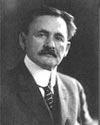Lesson One : A Brief History of Light
In 1704, Sir Isaac Newton explained light as a stream of tiny particles called corpuscles that moved through space. This view was widely accepted by scientists until 1801, when Sir Thomas Young proposed and experimentally demonstrated that light behaved like a wave. What type of wave remained to be seen, however.
During the 1800ís, James Clerk Maxwell answered this question in a round-about fashion by demonstrating that the theories of electricity and magnetism could be unified; which in turn predicted that light was an electromagnetic wave. Although Maxwell derived this prediction mathematically, it remained for Heinrich Hertz to experimentally verify his prediction in 1887, eight years after Maxwell's death.
For a long time, it was assumed that electromagnetic waves - like all of the other mechanical waves that were known at the time - traveled through some medium. This mysterious medium was known as the ether. In 1881, however, Albert Michelson shocked the scientific community by demonstrating that there was no ether. His discovery met with such incredulity that he and a colleague, Edward Morley, repeated the experiment with greater accuracy in 1887, just to be sure. Their results were the same: light, confirmed to be an electromagnetic wave by Hertz, was able to travel through empty space on its own.

Sir Isaac Newton

James Clark Maxwell

Sir Thomas Young

Albert Michelson



